Episode 168
What you’ll learn in this episode:
- Why being a jewelry artist is like being an engineer
- How Barbara got her jewelry in the hands of famous rock-and-rollers like David Bowie and the Rolling Stones
- Why Barbara doesn’t separate her jewelry into women’s and men’s lines
- Why talent is only a small part of what it takes to become a successful jeweler
About Barbara Klar
Barbara Klar was born in Akron, OH, with an almost obsessive attention for details. The clasps on her mother’s watch, the nuts, bolts and hinges found on her father’s workbench, the chrome on her brother’s ’54 Harley Hog…Barbara’s love of hardware and metal and “how things worked” was ignited and continues to burn bright.
Coming of age in the Midwest, Barbara was part of the burgeoning glam rock explosion making the scene, discovering Pere Ubu, DEVO, The Runaways, Iggy Pop and David Bowie in out-of-the-way Cleveland nightclubs. Cue Barbara’s love of music and pop culture that carries on to this day.
New York…late 1970’s, early 80’s. Barbara began making “stage wear” for friends in seminal punk rock bands including Lydia Lunch, The Voidoids and The Bush Tetras, cementing Barbara’s place in alt. rock history as the go-to dresser for those seeking the most stylish, the most cutting edge accessories. She certainly caught the attention of infamous retailer Barneys New York, who purchased Barbara’s buffalo skin pouch belts, complete with “bullet loops” for lipstick compartments. Pretty prestigious for a first-time designer!
Famed jeweler Robert Lee Morris invited Barbara into a group show at Art Wear and Barbara joyfully began to sell her jewelry for the first time. Barbara opened her first standalone store, Clear Metals, in NYC’s East Village during the mid – 80’s. In 1991 she moved that store into the fashion and shopping Mecca that is SoHo, where it was located for ten years until Barbara has moved her life and studio upstate to the Hudson Valley. She continues to grow her business, her wholesale line and her special commission work while still focusing on those gorgeous clouds in the country sky.
Barbara’s work has been recognized on the editorial pages of Vogue, WWD, The New York Times and In-Style Magazine as well as featured on television shows including “Friends,” “Veronica’s Closet” and “Judging Amy.” Film credits have included “Meet The Parents,” Wall Street,” “High Art” and The Eurythmics’ “Missionary Man” video.
Barbara has been hailed in New York Magazine as being one of the few jewelry designers who “will lend her eclectic touch to create just about anything her clients request, from unique wedding bands and pearl-drop earrings to chunky ID bracelets and mediaeval-style chains.”
Additional Resources:
Photos:
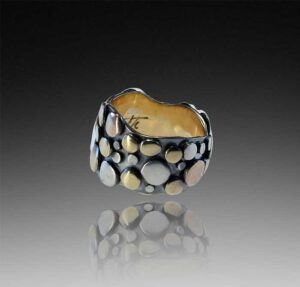
Art Smith reproduction ring (w/polka dots)
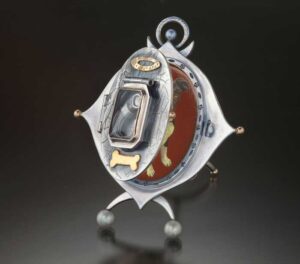
“My Buddy” Reliquary
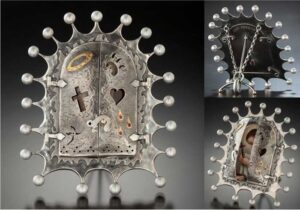
“The Seeker” Reliquary
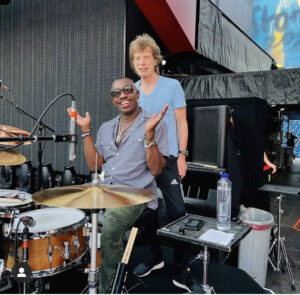
Steve Jordan (wearing my jewelry) w/Mick Jagger
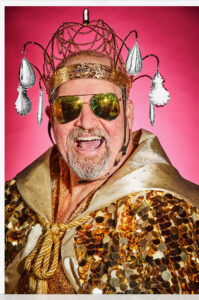
The Tiara I made for performance artist Chris Wells of “The Secret City” group
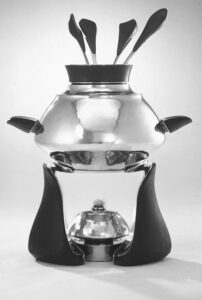
My BFA/CIA Thesis, The Fondue Set
Transcript:
Barbara Klar’s jewelry has been worn by the like of David Bowie, Steve Jordan and Joan Jett, but Barbara’s celebrity fans are just the icing on the cake of her long career. What really inspires her is connecting with clients and finding ways to make their ideas come to fruition. She joined the Jewelry Journey Podcast to talk about the crash course in business she got when she opened her store in 1984 in New York City; why making jewelry is often an engineering challenge; and why she considers talent the least important factor in her success. Read the episode transcript here.
Sharon: Hello, everyone. Welcome to the Jewelry Journey Podcast. This is the second part of a two-part episode. If you haven’t heard part one, please go to TheJewelryJourney.com. Today, my guest is Barbara Klar, founder and owner of Clear Metals. Welcome back.
So, is your studio inside your home now?
Barbara: Yes, it is. It always has been. One time, I tried to have my studio in the back room of my store in SoHo. That just didn’t work at all. If they know I’m there, everybody is like, “Is Barbara here?” I could never get any work done. Eventually, I was able to get a building in Williamsburg and have my studios there. It was a great building because it had been a doctor’s office in the 50s, so there was a little living space in the back and the front had been all the examination rooms. That worked out perfectly for my studio at the time.
Sharon: And you’re in Woodstock, New York now?
Barbara: Yes, I am. I love it here.
Sharon: Had you moved there before Covid, or is that just an area you like?
Barbara: I’ve been here about six years now. I’ve been all over the Hudson Valley. I think I moved here prior to Covid. It’s a very arty town and full of weirdos and like-minded people. It’s a cool place. It has the history of Bird-On-A-Cliff, which was where all the Hudson Valley artists started. It started as an arts colony. So, it’s got that history, and it’s nice to be part of a history.
When I had my store—and I loved my store on 7th Steet in the East Village—I was so akin and felt such a vibe from the previous generations of jewelers that had stores on 8th Street in the West Village. It was a complete circle to me, and I feel that way now as well.
Sharon: So, you targeted Woodstock or this area to live in?
Barbara: No, I was going through a breakup. It was very painful. I found a place here. I knew it would be my home and my love. I was lucky. It’s one of those guided journeys.
Sharon: Looking behind you, I can see you have quite a well-developed studio. You have all your tools. It doesn’t seem like you’d be missing anything there.
Barbara: Definitely not. It’s great.
Sharon: Did you start out that way? Did you collect the tools throughout the years?
Barbara: Since 1979, I’ve been collecting tools. There’s always something else you need as a jeweler and a metalsmith. About 10 years ago I sold my house, which was a little bit south of Woodstock, and got rid of everything except my studio and my clothes. That’s where I’m at now, and it feels so good to not be buried with stuff. I just have my workshop, and that’s basically it.
Sharon: That’s the important thing, having your workshop. I don’t know if you still do, but you had a very successful line of men’s jewelry.
Barbara: Yeah, I was one of the first to do men’s jewelry. That was probably in the late 80s, early 90s. I’ve done a lot of men’s. I had a lot of gay male clientele. They were always coming in, and they had a large disposable income. It worked out great. I love to see a man in jewelry. I love what’s happened with the metrosexuals in the last eight or nine years. Even the nonbinary and straight males are feeling more comfortable with jewelry, and I think it’s really great. Coming from a rock background, you see a lot of flamboyancy on stage, and you see a lot of guys flashing metal. I think it looks great.
Sharon: It that what prompted you to develop this line? Did you ever sell it? Was it a production line or was it one-off? How was it?
Barbara: It’s limited production always. I had a friend ask me recently, “Barbara, on your website, why don’t you have a category that’s specifically men’s jewelry?” I said, “I’ll never do that because I can never tell what a man’s going to like.” With all of this large spectrum of gender identity, I can’t tell what somebody’s going to like. That’s not up to me, to decide what men’s jewelry is. So, I never really bought into that, but I know men and kids seem to like my work.
Sharon: They look in your window and come in and say, “I’d like to try that on”?
Barbara: Yeah, especially some of the bigger rings. I was always surprised what was attractive to them. Also, there’s a lot of word of mouth. I never relied on advertising. I got a lot of press, which didn’t seem to do much, but mostly it’s because of word of mouth that people come to me.
Sharon: Is the press how you developed your celebrity clientele? You were mentioning that you have quite a roster or that you’ve done a lot for celebrities.
Barbara: Yeah, that just kind of happened. In my store in SoHo, I used to have what I would call my “deli wall.” You know how you go into a deli in New York and you see all of the celebrities saying, “Oh, thanks for that corned beef sandwich. It was the best I had”? I had that in the background. Over time, celebrities would come in. A lot of stylists would bring celebrities. I developed the deli wall, and it was word of mouth again.
Sharon: I always wonder when I look at a deli wall if they ask people for their signatures, if they have a stack of photos in the back and say, “Would you sign this?” How did that work for you?
Barbara: I’d always ask them. It’s hard to do sometimes. I don’t want to overstep because every celebrity reacts differently to being recognized and interacting, but you’ve just got to do it. It’s funny; I’m impressed, but I know they’re human just like me. On my website, I sometimes look at the marketing stats, and that page is the most visited page. Here in America, we love our celebrities.
I know a lot of them had a big impact on me, so I get it. Once I waited in line for half a day because I made this belt for Tina Turner. She was signing records at Tower Records in New York City. I went up to her and showed her the belt, and I was so excited because she meant a lot me. She got me through a couple of breakups that were pretty devastating. So, I get it. I’m a fan. Definitely, I’m a fan.
Sharon: What did she say when she saw the belt?
Barbara: She was like, “Oh, I love it. I just love it.” She said, “I’m going to wear it.” I never saw her wearing it, but she was very kind and wonderful and gracious.
Sharon: That takes guts on your part, just to show a belt to a celebrity like that.
Barbara: It’s not comfortable for me because I’m very shy. I’m really a shy person. I even tried being in bands. My friends were in bands. I work better behind the scenes, but sometimes you have to jump off that cliff. I’m one of these people that I might be shy, but I’m also brave. I’ll take a risk. I think in these times, with the all the competition out there, especially for jewelry designers, you have to take a risk and you have to be brave.
Sharon: Yes, absolutely. It’s amazing to me; so many people I talk to who make jewelry, they say they’re shy, but you have to put yourself out there. You have to put your product out there. You can’t just sit in your studio.
Barbara: You can’t, and you also have to be able to talk about your work. There was a relationship I had at one time, and we had these arguments because he would make this incredible work. I would say, “What does it mean? How would you explain it? How would you define it?” and he would say, “Well, I’m not going to do that. If I have to do that, it negates everything. People should be able to draw their own opinions about what I’m saying.” I was like, “No, I don’t agree. I think you should be able to say what your intention was, how you see it. If it’s interpreted differently, that’s an extra plus in my mind.” I think everybody should be able to talk about their work.
Sharon: Especially if you are doing what I’ll call art jewelry. You’re not walking into a place like Tiffany, let say. That’s the only one of its kind.
Barbara: Exactly. The one-of-a-kinds are like that. When I had my store in SoHo, the greatest thing that was the most fun for me was making an inspirational thing that I thought nobody would ever wear or buy and putting it in the window, because that would get people to come in. They were outrageous; they were huge, and often I would sell those pieces. It was a shock to me.
Sharon: How did it feel to see celebrities, such as Steve Jordan, wearing what you made?
Barbara: It’s pretty incredible. Once it leaves my hands, it takes on its own journey. It’s an ego boost for a minute, but then you’ve got to make a living the rest of the time. I’ve been in this business so long, and you think, “Oh my God, I got my stuff on the Rolling Stones tour. It’s so great.” It’s impressive to people when you’re at a party and you can say that. Ultimately, it means nothing. Has he mentioned my name or anything on the Rolling Stones tour? No. That may never happen, and that’s fine. I don’t care. It’s fun.
Sharon: Is it validation to other people if you’re showing your work or talking about it, and you say a certain celebrity wore it? Isn’t that validation in a sense?
Barbara: It is. I try not to buy into that too much. The validation really comes from myself. I know what I’m doing. It’s fine. I don’t really need that, but that’s an extra special perk, I must say.
Sharon: A validation for you, but also—I’m not sure it would sway me, but for a lot of people—it depends on who the celebrity is, but it could sway somebody. They might say, “If ABC person wore it, then I want one like it.”
Barbara: Oh yeah, definitely. It works that way. To a lot of my rock-and-roll friends, the fact that I’ve sold a lot of work to Steven Tyler or Steve Jordan means something. Sometimes they’ll come to me with special commissions. One of my first commissions when I had my store in SoHo was for a client who had been to London, and he was obsessed with Keith Richards and the bracelet he always wears. He wears this incredible bracelet made by Crazy Pig Studios in London. He came to me and said he wanted me to make a bracelet like the one Keith Richards wears. I said, “Why would you have me do it? Why don’t you dial Crazy Pig in London and get the same bracelet?” He said, “Oh, I was in there. They were mean. They were really intimidating. I don’t want to give them my money.” So, I said, “All right. It’s going to be a little different, but I’ll make one for you,” and I made this incredible bracelet. I still sell it today. It’s the Keith Richards bracelet. It’s a fun story.
Sharon: Wow! Yeah, that is a fun story. You’re also writing a book now. Tell us a little about the title.
Barbara: Titles are interchangeable, but this has been the title for a while. It’s called “You’re So Talented.” I’m not sure what the subtitle is going to be exactly, but it could be “It Takes More Than Talent” or “Confessions of a Worker Bee.” It’s basically about my stories, my experiences not being a businessperson and being more of an artist, surviving New York. A lot of stories. It’s geared towards kids who have a lot of talent, but that’s not all it takes. Talent is like two percent of what it takes to be successful and to be creative and to be a survivor.
Surviving in New York City was such an incredible challenge, especially when you’re living and working on the street level. You can’t control what comes into your space. You don’t know how business is done. I had just opened my store in the East Village. I was 24 or something, and this big bruiser guy comes into my store and is like, “You gotta pay me for sanitation pickup.” I said, “What? I have to pay for sanitation? I thought the landlord took care of that.” He said, “No, we pick it up.” I’m like, “Well, how much do you want?” He said, “We want $75 a month.” I said, “What? I can’t pay that. I can barely pay my rent.” He said, “Well, how much can you pay?” and I said, “Well, I can pay like $15.” He said, “O.K.” and he walked out. Wouldn’t you know, every month he was there for his $15. It was crazy.
Sharon: You were honest, but you had to become a businessperson over the years.
Barbara: It was such a challenge. I have to tell you, another successful designer once said to me, “Nothing teaches you about money like not having any.” I think that was one of the wisest words, because I learned how to become my own bookkeeper, my own press person, my own rep. I also had to pay all the employee taxes, navigate the business end of it, try to get business loans. That was such an experience. I heard 2Roses talking about this on your podcast, too, about how business should be included in art school training. I was totally thrown out there and totally naïve.
Sharon: It sounds like the school of hard knocks.
Barbara: Definitely.
Sharon: And that’s what the book is about?
Barbara: Yes. People say, “You’re so talented.” If I had a quarter for every time somebody said that to me, I’d be rich. No, it’s not about that. It’s about perseverance, and it’s about hearing a lot of “no’s.” It’s about coming through the back door instead of the front door. The book is about things that were on my journey that were important and meaningful to me, and that I think young people could learn something from about moving to New York as an artist. It’s very different now. I don’t claim to know the ins and outs of New York City at this point in life, but I think my journey is still relevant.
Sharon: Definitely. I’m curious how you took the “no’s,” because you must have heard a lot of “no’s.”
Barbara: So many. It gets you to that next point. A no is actually good, because you’re forced to meet up with another solution or another path. I’ll never forget; I wanted to be like Robert Lee Morris, who had his work everywhere and bought a ranch in New Mexico and everything. I remember being tested for QVC in the 80s. They were having young designers on QVC. I did the test, and I heard them in the background saying, “I don’t know if she works well on camera. She might be a little too quirky. Her work is a little too eclectic.” I was like, “Oh God, really?” So, I was like, “You know what? I don’t care. That’s my thing. Maybe I don’t want to be a production person.”
I looked into having my work made overseas and all of that, and I realized, in the end, I would just be a manufacturer. For me, the art was more important. The hands-on making was more important. The person-to-person contact, communication with my clients and my employees was really important to me. I enjoy that way more than if I had been basically a business owner.
Sharon: It’s having the mark of the hand on it. If I know that you crafted it or somebody crafted it, it has much more meaning, I think.
Barbara: Absolutely. It means a lot to me. Recently I had a client whose mother was a big jewelry collector and had a couple of Art Smith rings. The client had lost one of the rings in the pair in Provincetown. It went into the ocean, gone. I was able to hold the matching ring in my hand and look at it and see a signature, because the client wanted me to recreate this ring, which I did do. But the whole time I was making this ring, I kept imaging Art. The ring was covered in dots of silver and pink gold and yellow gold. It’s a beautiful ring, very asymmetrical. The dots were raised like a half a millimeter off the band, and there were like 50 dots on this ring. So, I’m thinking of him making this ring in his studio. Every dot had to have a peg soldered onto the back before it was soldered onto the band. I did that 50 times, and I’m thinking, “My God, this guy was tenacious.” I had a lot of respect.
Sharon: How did you decide to start writing a blog? You write a blog. How did that come about?
Barbara: I really enjoy writing, and there are things I wanted to say that the work couldn’t say by itself. One of the things I’ve always been obsessed with since I was a child are charms. When I was five, Sherry Carr across the street from me had a shoebox full of charms, like the bubblegum charms, and I coveted that box. I was obsessed with that box. Every time I would see it, I would be like, “Show me the charms.” I wanted to knock Sherry out so I could get that charm. I started collecting charms at a very young age. They mean a lot to me, and they mean a lot to my clients. I talked about that in one of my blog posts. I think that was one of my first blogs, talking about charms and the meaning they hold for us. I think the spiritual side is important to me, the emotion you put to it and how it goes on the body. It’s for the body.
Sharon: Well, you have very eclectic jewelry, very unique jewelry. Barbara, thank you so much for being here today.
Barbara: I loved it. Thanks so much.
Thank you again for listening. Please leave us a rating and review so we can help others start their own jewelry journey.

